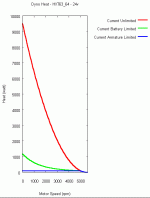safe
1 GW
- Joined
- Dec 22, 2006
- Messages
- 5,681
No go... the Kv @ 332 RPM / Volt is too high.erth64net said:Scorpion 4025-16
The other one's Kv @ 200 RPM / Volt... is easier to deal with. :wink:
No go... the Kv @ 332 RPM / Volt is too high.erth64net said:Scorpion 4025-16
safe said:You (and I) both got excited about the motor price and then realized quickly afterwards:
"Oh no... now how do you use it?"
...everything that recumpence has been doing for the last six months or more applies to solving the gearing issue. There are all kinds of additional work needed to make it functional on an ebike.
---------------------------
The MY1016Z3 with the 10:1 geardown is a simple bolt on to my bike and the sprocket they give with the motor fits perfectly into my gearing plans. So for the bike I'm doing now (Project #003 as seen in my present avatar) I'm not going to change anything.
But I'm starting to follow the RC threads closer and closer because the performance is just sooooooooo good with these that they are the eventual destination for all of us.
Doing the math:GGoodrum said:I think if I were going to try one of these, it would be the larger version: https://www.hobbycity.com/hobbycity/store/uh_viewItem.asp?idProduct=5139
You certainly won't get 90% efficiency from those budget HXT motors.... you'll be lucky if you get over 80%... and then you have to add on any additional reduction losses...safe said:If the RC motor is 90% efficient, then my power output is .....
Efficiency is mostly a matter of lower resistance. Lower resistance motors tend to be more efficient than higher resistance motors. Unfortunately the specification for resistance is conspicuously absent on the HXT 63-74, but the one with the same price right next to it has 28 mohm which is very good.Miles said:You certainly won't get 90% efficiency from those budget HXT motors.... you'll be lucky if you get over 80%... and then you have to add on any additional reduction losses...

safe said:No go... the Kv @ 332 RPM / Volt is too high.erth64net said:Scorpion 4025-16
The other one's Kv @ 200 RPM / Volt... is easier to deal with. :wink:
safe said:Efficiency is mostly a matter of lower resistance. Lower resistance motors tend to be more efficient than higher resistance motors. Unfortunately the specification for resistance is conspicuously absent on the HXT 63-74, but the one with the same price right next to it has 28 mohm which is very good.Miles said:You certainly won't get 90% efficiency from those budget HXT motors.... you'll be lucky if you get over 80%... and then you have to add on any additional reduction losses...
safe said:Is there a website devoted to classifying and rating all these RC motors?
Good intentions, possibly bad results; these motors are designed to be run at certain loads & speeds, if run too far under their designed-for capacity, then you're actually hindering performance and cutting efficiency...at what cost...a couple of $20's? Hmm, I'd rather buy the better motor, do less maintenance, carry around fewer batteries, and simply deal with fewer complications...by going with a more established and proven brand. Personally, I'm building something that'll Just Work, without a bunch of tuning & tweaking over the long-term.safe said:I also like to buy something and run it UNDER it's limit.
safe said:My little pearl of wisdom would be:
"If you spend time trying to make your ebike more efficient shouldn't you also make your money more efficient?"
The thing about electric motors is that when they are run "lean" (as in at the higher rpm nearer to the max efficiency) they tend to use less heat and run more efficiently.Bobocop said:...whats the point of paying $60 + for a motor thats going to over heat and have bearings blow up and magnets coming loose.
This is an often misunderstood point though...Ypedal said:Safe.. you really need to stop trying to give advice... please...



From the way I understand it (and it took me a long time to accept that PWM really works this way) the motors tend to have a certain degree of inductance. When there is a lot of "space" between the pulses that more or less allows whatever current to flow in a less restrictive manner. The way I try to view it is to think of a traffic mess in a busy freeway... if you have an empty freeway you can travel at 80 mph if you want. But if there is a lot of traffic then the cars start to order themselves in such a way that the speeds are lower, but the volume is the same. Basically PWM means that total power is a constant and voltage and current are proportionally opposite to each other. (when using battery current limiting)JEB said:If you make a hi freq. pulse width generator, well filtered output, that would effectly lower the input voltage to the rc motor/controller would that reduce the current into the motor to a acceptable level?


